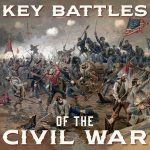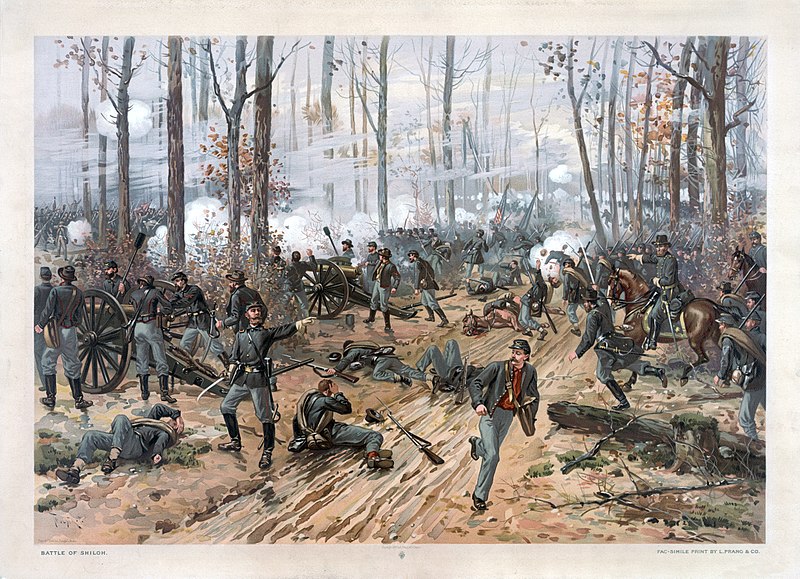The Background of the Battle of Shiloh
The behind scene of Battle of Shiloh is that in Virginia, Stonewall Jackson kept the Federals baffled in the Shenandoah Valley and fearful of a possible Confederate attack on Washington; that, and the fact that General George McClellan was now in command of Federal forces, meant stasis on the Eastern front.
In the West, things were going badly for the Confederacy. Confederate General (and Episcopal bishop) Leonidas Polk had been the first to trespass troops into officially neutral Kentucky (which had a pro-Confederate governor and a pro-Union legislature), but the Federal counterthrust put much of the state in Union hands. Missouri was a goner too, and Federal troops were on the march in Arkansas and Tennessee.
The Union hero of the West was Ulysess S. Grant—a fighting general whose victory at Fort Donelson, Tennessee, 16 February 1862 had won him the nickname of “Unconditional Surrender” Grant. Grant was now at Pittsburgh Landing, Tennessee. Grant’s Union army of the Tennessee had 42,000 troops (37,000 immediately at hand, 5,000 a short march away) and he was looking to combine his forces with General Don Carlos Buell’s Army of the Ohio, numbering about 50,000 men, who were occupying Nashville.
Before these two giant Union armies merged, Confederate General Albert Sidney Johnston wanted to smash one of them. A Kentucky-born, Louisiana-raised West Pointer, before the war Johnston had been considered the finest Southern officer in the Army. As the Confederate West crumbled, his reputation had crumbled too. Attacking Grant was to be his redemption; the result was the battle of Shiloh.
The Battle :
Beauregard, Johnston’s second-in-command, had drawn up the plan, and at dawn, Sunday, 6 April 1862, Johnston’s rebel-yelling Confederates put it into action, bursting upon the unprepared Union encampment, announcing themselves by shooting dead an aide standing next to General Sherman. The Confederates drove the Federals back: Sherman was on the Union right, General John McClernand holding the Union center behind the Shiloh church. On the Union left was General Benjamin Prentiss, whose troops found a sunken road forming a natural trench where they could reform and mow down charging Confederates. The rebels dubbed this part of the Yankee line “the Hornets’ Nest.” The Confederate attack all along the line was so powerful that Grant thought he was facing 100,000 men—and it is proof of his mettle that he resolved to fight it out.
The Hornets’ Nest held together—even under Confederate artillery attack—but no other part of the Union line did, as Sherman and McClernand continued their fighting retreats. With Confederates encircling the nest, and more than half of his men dead, Prentiss finally surrendered. As daylight petered out, Beauregard called off any further advances. Albert Sidney Johnston was dead—killed leading a charge against a heavily fortified peach orchard near the Hornets’ Nest—but the Confederates had won the field. Beauregard thought his men needed to be regrouped; they could finish off Grant’s army in the morning.
But Grant was resolute. In the morning, with 26,000 reinforcements, he counterattacked, and in a military danse macabre, the battle of the day before was repeated, though this time it was the rebels who fought on the retreat. By mid-afternoon, the Federals had pushed all the way back to their original lines, and Beauregard conceded the ground.
What You Need to Know:
There were more casualties—24,000—at Shiloh than there had been in the American War of Independence, the War of 1812, and the Mexican War combined, and yet the battle itself was a bloody draw. After battle of Shiloh, Grant said: “I gave up all idea of saving the Union except by complete conquest.”
The Battle of Shiloh was a battle in the Western Theater fought April 6–7, 1862, in southwestern Tennessee. On the first morning, 40,000 Confederate troops struck Union Soldiers at Pittsburg Landing. They were under the command of Major General Ulysses S. Grant. The Confederate Army of Mississippi, under the command of General Albert Sidney Johnston, launched a surprise attack on Grant’s army from its base in Corinth, Mississippi. Johnston was mortally wounded during the fighting; Beauregard took command of the army and decided against pressing the attack late in the evening. Overnight, Grant was reinforced by one of his divisions stationed further north and was joined by three divisions. The Union forces began an counterattack the next morning which reversed the Confederate gains of the previous day.
The Battle of Shiloh
- February – April 1862
-
-
- Mental Map
- Jefferson Davis sent General Beauregard west to take command of the western divisions of Johnston’s army. Beauregard planned to concentrate his forces at Corinth, a key railroad junction town in NE Tennessee. Johnston was ordered to join him.
- For the Union, Halleck was put in charge of the entire western theater. Now Buell reported to him (Grant still did).
- Halleck ordered Grant to march his army to the town of Pittsburg Landing, on the Tennessee River in SW Tennessee, and just north of Corinth. He also ordered Buell to march there and reinforce Grant. The plan was to then attack the Confederate forces at Corinth. For now, he camped near a church called “Shiloh” (“Place of Peace”).
- (Quick background on Grant…West Point, Mexican War, drinking accusations, resignation from Army in 1854, failure in several careers, rejoined Army, Battle of Belmont)
- The Confederates used railroads to send troops from several places in the South to concentrate troops at Corinth.
- By early April, Grant had about 42,000 troops, while Johnston and Beauregard had about 40,000. Buell’s 20,000 troops were on the way.
- The Confederate commanders decided to attack Grant before he could be reinforced by Buell.
-
- April 6
-
- On April 3, Johnston’s army began marching toward Grant. Johnston hoped he would surprise the bluecoats. He said “I would fight them if they were a million.” The march takes much longer than planned, due to muddy roads.
- Grant’s army had the Tennessee River to their back, so retreat was not an option.
- The Confederates marched forward in four lines. They were VERY inexperienced, and they did not get in place until the afternoon of April 5. They made a great deal of noise on the way.
- Despite this, the Federals were completely surprised when the attack began early on the morning of the sixth.
- The Confederates pushed the Federals back toward the river. Johnston said to his commanders “Gentlemen, tonight we water our horses in the Tennessee River.”
- The fighting was savage. The Federals continued to give way on the right and left, but the center held strong in an oak thicket that came to be called “The Hornet’s Nest.” Many bluecoats retreated in panic, but Grant remained calm.
- The Confederates could have made major progress by moving along the river and pushing the Union right back, but they did not. Instead, they devoted all their attention to the “Hornet’s Nest.”
- By 5 PM, the Confederates had taken the Hornet’s Nest (capturing 2000 men) and had pushed the Federals back to a new position near Pittsburg Landing.
- By this time, Johnston had been killed, and command had passed to Beauregard. He decided to halt the attack and resume it the next day. He thought Earl Van Dorn was on his way and that Buell would not be able to reinforce Grant. Beauregard wired Jefferson Davis, saying he had won a great victory and that he would finish it tomorrow.
- Grant’s subordinate Gen. William T. Sherman remarked, “Well, Grant, we’ve had the devil’s own day, haven’t we?” Grant replied, “Yes. Lick ’em tomorrow, though.”
- April 7
-
-
- All night, a thunderstorm rages. wounded men screamed and cried for help.
- There were so many dead that Grant said it was possible to walk across the battlefield in any direction, stepping on bodies without a foot touching the ground.
- During the night, Buell’s army reached Grant’s position and crossed the river to join him. This gave Grant 20,000 fresh troops.
- Confederate cavalry general Nathan Bedford Forrest tried to warn his fellow Confederate generals about Buell’s arrival, but no one paid him attention.
- Van Dorn never arrived to reinforce Beauregard.
- On the morning of the 7th, Grant launched a counterattack. The Federals pushed the Confederates back, gradually retaking the ground they had lost the day before.
- Beauregard decided to retreat. Grant held the field.
- Confederate Cavalry commander Nathan Bedford Forrest and his forces covered the Confederate retreat.
-
- Outcome/Consequences
-
- The Confederates suffered about 11,000 casualties (1700 K, 8000 W, 950 C/M), while the Union lost 13,000 (1800 K, 8400 W, 2900 C/M).
- The Confederacy lost one of its best generals.
- There were more casualties at battle of Shiloh than in all previous American battles combined.
- One New Orleans resident wrote “After Shiloh, the South never smiled again.”
- Grant’s reputation as a hero was enhanced (although some of his critics falsely accused him of being drunk when the battle began).
- The Union gained a firm hold on Tennessee. Never again did the Confederacy have a serious chance of regaining it.
- Grant realized that the war would have to be a war of total conquest.
Subsequent Developments in the West
- On April 25, a combined Union army and fleet captured New Orleans (largest city in the Confederacy and the gateway to the Mississippi River).
- After battle of Shiloh, Halleck came South, personally took command of Grant’s and Buell’s forces, and led them to Corinth, MS, which they captured. ” Scott mentions in general: Major General Henry Wager Halleck, commander of the Western Theater, led one of the most painfully slow and disappointing campaigns of the Civil War. The so-called Corinth Campaign in the spring of 1862 was so farcical and such a waste of Union manpower that it scarcely deserves to be called a campaign.
- In June, another Union force captured Memphis. Now, the Federals controlled nearly all of the Mississippi.
- All of these developments greatly demoralized the Confederacy.
- Beauregard was removed from command.
 Would you like to learn the complete history of the Civil War? Click here for our podcast series Key Battles of the Civil War
Would you like to learn the complete history of the Civil War? Click here for our podcast series Key Battles of the Civil War
Cite This Article
"The Battle of Shiloh (April 6-7, 1862)" History on the Net© 2000-2024, Salem Media.
April 20, 2024 <https://www.historyonthenet.com/battle-of-shiloh-6-7-april-1862>
More Citation Information.






